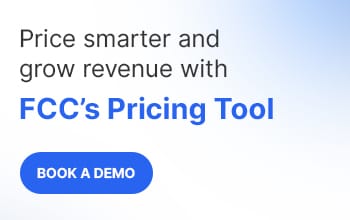Table of Contents
- What is Competitive Pricing?
- Advantages of Competitive Pricing
- Disadvantages of Competitive Pricing
- Competitive Pricing Examples
- Types of Competitive Pricing Strategies
- Best Practices for Competitor-Focused Pricing
- Tools to Help with Competitive Pricing
- Conclusion
What is Competitive Pricing?
Competitive pricing, also known as competitor-based pricing, is a marketing strategy in which businesses set their prices based on competitors' prices. This method is applicable in both online and offline markets and aims to attract more customers and increase market share. For this strategy to be effective, businesses must understand their competitors' pricing strategies and how consumers perceive value.
Competitive pricing involves selecting strategic price points to leverage market advantages. It is commonly used by businesses selling similar products, as product attributes remain consistent, unlike services. This approach is typically used when a product has reached market equilibrium with many substitutes available.
Advantages of competitive pricing
Implementing competitive pricing strategies requires monitoring competitors' pricing, but the rewards are substantial for retailers:
-
Increased Profits: By setting prices lower than competitors, retailers can increase profit margins while still undercutting rivals. Alternatively, matching competitors' prices and leveraging unique value propositions can close deals or higher prices can be set if product quality or innovation justifies it.
-
Customer Acquisition: Offering lower prices than competitors is an effective way for retailers to attract price-sensitive customers seeking the best deals.
-
Customer Retention: While relying solely on lower prices may not build a loyal customer base, offering competitive prices can help ensure increased satisfaction, repeat business, and higher customer lifetime value.
-
Market and Customer Insights: Successfully implementing a competitive pricing strategy requires an in-depth knowledge of market conditions and competitors' pricing approaches. This research provides clearer insights into customers and strengthens the value proposition.
-
Market Share Expansion: Brands like Walmart and Aldi have used aggressive, competitor-focused pricing strategies to rapidly expand market share before increasing prices once they achieve dominance.
Disadvantages of competitive pricing
Here are some significant reasons why competitor-focused pricing might not be suitable for your brand or market:
-
Limited Differentiation and Innovation: Retailers like Samsung didn't achieve global success by merely undercutting rivals. Instead, they focused on high-quality, innovative products and excellent customer support. Overemphasis on price competition can lead to neglecting innovation and differentiation. This might deter customers from choosing your products.
-
Potential Brand Image and Reputational Damage: While some consumers see low prices as excellent value, others equate low prices with poor quality. Relying on undercutting competitors can risk your brand being perceived as cheap and low-quality.
-
Reliance on Competitor Pricing and Market Conditions: Competitive pricing often means your rivals dictate your strategy. If they lower their prices, you may need to follow suit, constantly adjusting to market conditions. Additionally, if your costs increase and your competitors do not, raising your prices can be challenging, leading to tighter margins.
Competitive pricing examples
Here are examples of competitive pricing strategies used by leading brands:
-
Walmart: Walmart employs competitive pricing by consistently offering lower prices than its competitors. This strategy attracts price-sensitive customers and helps Walmart maintain its position as a leading retailer. By leveraging its vast supply chain and purchasing power, Walmart can negotiate lower prices from suppliers and pass the savings on to customers.
-
Target: Target uses competitive pricing to stay competitive in the retail market. For example, Target often matches or undercuts prices of similar products offered by competitors like Walmart and Best Buy. This approach helps Target attract customers looking for the best deals while maintaining its market share.
Types of competitive pricing strategies
When adopting a competitive pricing strategy, retailers have three primary options for setting prices for their goods or services:
-
Lower Prices: Setting product prices lower than competitors can be advantageous for retailers that can leverage economies of scale. This approach can also be part of a loss leader strategy, where goods or services are priced below profitability to attract new customers and drive sales of more profitable items.
-
Higher Prices: Retailers offering products with higher quality and advanced features may set prices higher than competitors. This premium pricing strategy is often used by well-established brands that provide luxury products, justifying the higher price point through quality and innovation.
-
Equal Prices: Setting prices equal to competitors' prices or the prevailing market rate allows retailers to differentiate themselves through unique shopping experiences or attractive product alternatives, such as sustainable materials or eco-friendly manufacturing processes. Price matching is another approach that enables retailers to stay competitive without constantly adjusting prices based on competitors' fluctuations.
Here are some additional considerations for retailers considering using competitive pricing:
-
Price Skimming: Introducing a new product at a premium price and gradually reducing it over time to ensure revenue maximization when demand is high.
-
Value-Based Pricing: Determining product prices based on the perceived value of a product or service can be a strategic approach to differentiated offerings.
Best Practices for competitor-focused pricing
Here are some best practices for leveraging competitor pricing to differentiate your brand, enhance your value proposition, and increase conversions:
-
Conduct Thorough Market Research and Analysis: Undertake a detailed competitive pricing analysis. Identify key competitors, build value propositions, set a study period, review pricing models, and track sales and discounts.
-
Establish Clear Pricing Objectives & Goals: Align your pricing strategy with your business goals, market position, and value proposition. Set clear pricing goals, such as market share growth, revenue maximization, or profit margin maintenance.
-
Use Market and Customer Insights: By analyzing historical sales data and customer insights, retailers can gain valuable insights into how different price points impact key metrics such as average order value, repeat purchase rates, and customer lifetime value. This information allows for informed pricing decisions.
-
Monitor & Adjust Prices Regularly: Continuously monitor and adjust prices based on supply chain disruptions, changes in customer demand, and new market entrants. Regularly review your pricing strategy to ensure it supports your business goals.
Tools to Help with competitive pricing
To effectively implement competitive pricing strategies, retailers can utilize robust pricing software from Flipkart Commerce Cloud, such as the Pricing Manager and Competitive Intelligence. FCC Pricing Platform is a cloud-based SaaS tool that helps retailers optimize their pricing strategies to maximize margins and volumes. It tracks, compares, and analyzes competitor price changes in real time, using machine learning models to understand the price elasticity of demand from previous sales data.
On the other hand, Competitive Intelligence provides retailers with insights into competitors' pricing strategies. It offers accurate product matching, scalable scraping, and custom reports, enabling businesses to analyze the competitive landscape and make informed pricing decisions. Together, these tools empower retailers to stay competitive and achieve their pricing objectives.
Conclusion
Competitive pricing is a strategic approach that helps businesses set prices based on competitors' pricing. It offers several advantages, such as attracting new customers, boosting profits, and fostering brand loyalty. However, it also comes with risks, including limited differentiation and potential brand image damage. By undertaking detailed market research, defining clear objectives, and actively monitoring prices, retailers can effectively implement competitive pricing to achieve their goals.
FAQ
Target employs competitor pricing by matching or undercutting prices of similar products offered by competitors like Walmart and Best Buy. This strategy helps Target attract price-sensitive customers and maintain its market share. For instance, Target often offers price match guarantees, ensuring customers receive the best deal available. This approach allows Target to stay competitive and appeal to a broad customer base.
Here are the three different types of competitive pricing strategies:
-
Price Leadership: Price leadership occurs when a leading firm in an industry sets the market price of goods or services, and other firms follow its lead. This dominant firm, known as the price leader, influences the market by setting prices that competitors feel compelled to match to maintain their market share.
-
Price Matching: Price matching is a strategy where a retailer matches or beats a competitor's price for an identical product. Customers provide proof of a lower price at a competitor's store, and the retailer adjusts their price accordingly to win over price-sensitive customers.
-
Price Discrimination: It is an approach wherein a seller charges varied prices for the same product to various customer segments. This strategy assumes that customers have varying willingness to pay and segments customers based on factors like demographics or location. This helps sellers optimize revenue by charging each group a price that aligns with their perceived value.
Companies use competitive pricing to position themselves strategically in the market by determining their prices according to competitors' pricing. This approach helps businesses attract new customers, increase market share, and boost profits.
By understanding competitors' pricing strategies, companies can make informed decisions to stay competitive. Additionally, competitive pricing allows businesses to respond effectively to market changes and consumer demand, ensuring they remain relevant and appealing to price-sensitive customers.

